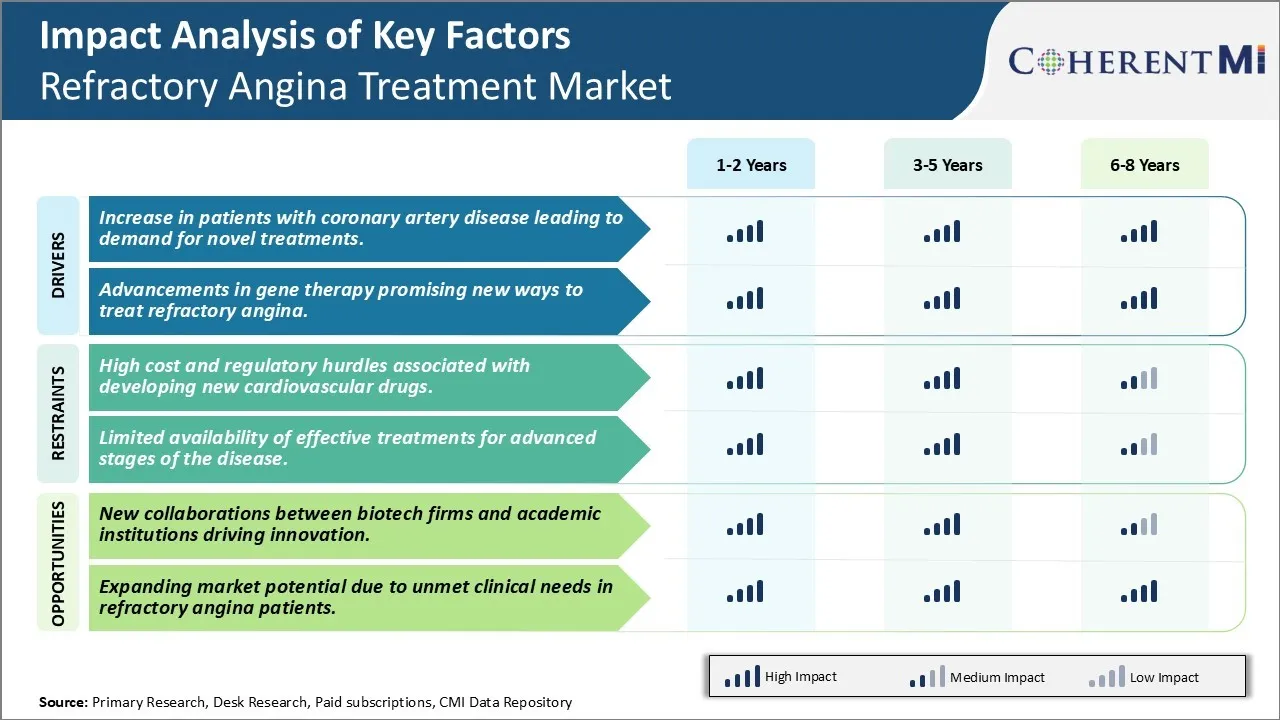Refractory Angina Treatment Market Trends
Market Driver - Increase in Patients with Coronary Artery Disease Leading to Demand for Novel Treatments
Coronary artery disease has been on the rise in past few decades across major markets such as United States, China and European countries. In United States alone, as per estimates from American Heart Association, over 605,000 new cases of myocardial infarction are reported each year, indicating increasing prevalence of atherosclerosis or narrowing of coronary arteries causing angina or chest pain. The number is expected to increase further with rising risk factors like obesity, unhealthy lifestyles and stress. Once coronary artery disease develops and patient experiences frequent or chronic angina symptoms that are refractory to conventional treatments, there are limited therapeutic options available and patient's quality of life declines significantly.
Current standard treatment for refractory angina includes optimizations of medical therapy with multiple anti-anginal drugs, revascularization therapies like coronary artery bypass grafting or angioplasty. However, in 15-30% of patients with severe coronary artery disease, these options are not feasible due to diffuse and extensive nature of blockages. This has created major unmet need for new treatment modalities that can improve symptoms, exercise tolerance and overall functioning of patients with few or no options left. Several pharmaceutical companies and clinical researchers are now focusing on developing novel drugs, devices and alternative treatment approaches targeting the underlying pathology and pathways involved in chronic angina symptoms. If successful, these new emerging therapies have potential to access a huge patient pool worldwide and bring considerable relief.
Market Driver - Advancements in Gene Therapy Promising New Ways to Treat Refractory Angina
Gene therapy is an evolving area of treatment with promising applications for various cardiovascular conditions. In case of refractory angina, researchers are exploring possibility of gene transfer methods to supplement deficiency of specific genes involved in regulation of blood vessels, myocardial function and response to ischemia. One such approach involves delivery of vascular endothelial growth factor (VEGF) gene to stimulate growth of collateral blood vessels in heart via angiogenesis. In animal studies, transfer of VEGF gene directly to heart muscle via gene delivery vehicles has shown to induce growth of new microvessels and reduce anginal symptoms. Similarly, boosting expression of certain cardioprotective proteins through gene therapy hold potential to make heart muscle more resistant to ischemia.
Several biotech companies are working on formulating safe and targeted gene delivery systems like modified viruses, liposomes or nanoparticles to transfer therapeutic genes specifically to cardiac tissues. Ongoing phase 1 and 2 clinical trials have demonstrated feasibility and safety of intravenous or intracoronary administration of gene therapy vectors in patients with no option left. If proven effective in reducing angina frequency and improving functional status in later stage trials, gene therapy interventions may emerge as invaluable treatment strategies especially for those not responding to other modalities. With further enhancements, this approach also offers possibility of one-time treatment eliminating need for lifelong medication intake.

Market Challenge - High Cost and Regulatory Hurdles Associated with Developing New Cardiovascular Drugs
One of the major challenges faced in the refractory angina treatment market is the high cost and strict regulatory requirements associated with developing new cardiovascular drugs. Bringing a new drug to the market involves extensive research and development over many years along with large clinical trials to prove the safety and efficacy of the drug. This drug development process is both time consuming and expensive, with costs often estimated in the hundreds of millions of dollars. Additionally, regulatory requirements from bodies like the FDA are intensely rigorous for drugs intended to treat serious heart conditions. Extensive documentation must be provided across non-clinical and clinical testing to receive approval. Any issues can lead in further loss of opportunity. This heavy investment burden combined with stringent regulations deters many smaller biotech and pharmaceutical companies from pursuing new refractory angina therapies. The risk of drug development failure or delays in approval also makes investors wary, limiting the financing options for innovators in this field. Overcoming these financial and regulatory hurdles is a major challenge restricting growth in refractory angina treatment solutions.
Market Opportunity - New Collaborations Between Biotech Firms and Academic Institutions Driving Innovation
One opportunity in the refractory angina treatment market is the increasing collaborations between biotech firms and academic medical centers. By linking up with universities and research hospitals, biotech companies are able to tap into cutting-edge research that may provide novel drug targets or approaches. Academic institutions have significant expertise but often lack the resources and experience to fully develop new therapies. Biotech companies meanwhile have drug development capabilities but benefit from access to fresh ideas and research coming out of academic labs. These partnerships are driving more innovation by bringing together the complementary strengths of both sectors. They allow academic discoveries to be advanced further into applied clinical research and commercialization more quickly. Such collaborations are also enabling more risk sharing across the drug development process and spreading costs among multiple partners. This new model of open innovation through cross-sector alliances is opening up more potential for refractory angina treatment breakthroughs that can address unmet needs in the market.